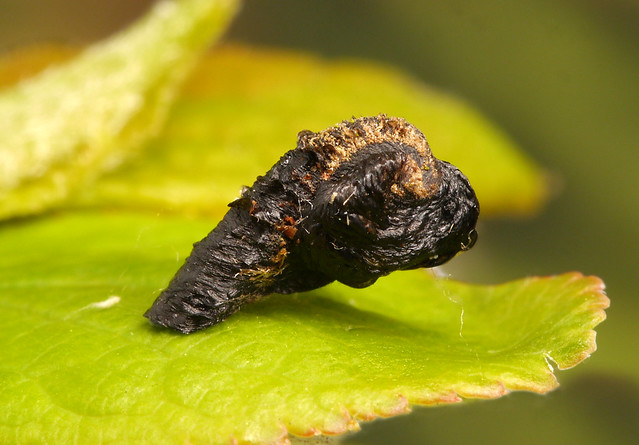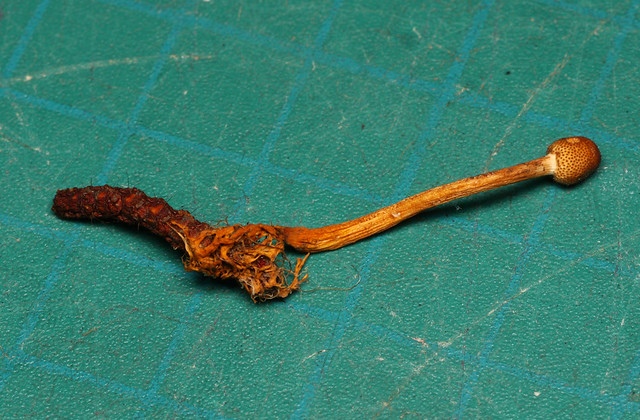It's viewable from this link (I hope): https://drive.google.com/file/d/0B4cFsPwrB4WnOE9QZ19DNnNJa0k/view?usp=sharing
You can sponsor a moth!
Peter Hall
Thursday, 27 April 2017
Tuesday, 25 April 2017
Plastic-eating greater wax moth may help solve pollution crisis
This article appeared on Sky New yesterday. No plastic moth pots for this one methinks.
Monday, 24 April 2017
Grove Farm Revisited
 |
| Stigmella crataegella |
 |
| Epinotia subsequana |
 |
| Epinotia subsequana |
 |
| Cydia strobilella |
Saturday, 22 April 2017
Garden mothing in Bewdley
April has seen quality but not quantity-last week had our second record of Broom Tip and last night our second record of an unusually early Barred Hook Tip. Few micros but did manage a Incurvaria Pectinea flying around the garden in the sunshine and quickly transported into a pot for closer inspection-a female.
Friday, 21 April 2017
Halesowen 20th April
 |
| Cochylis atricapitana |
Oak-tree Pugs had largely replaced Brindled and there was one Golden-rod Pug, NFY. A couple of very tired looking overwintering species in the form of Acleris schalleriana and Acleris hastiana were still hanging on.
 |
| Oak-tree Pug |
P.S. Just dissected a very battered Noctuid from last night which is White-marked, a first for the garden!
 |
| Golden-rod Pug |
Monday, 17 April 2017
Emperors Update!
Well, it wasn't so long after posting the previous entry, that the first wild male arrived. They are fast fliers and look very much like a butterfly in the air, but with quite an erratic flight pattern around the females. This one flew as far as 40 yards away in all directions before heading back again. It is rare to get Emperor coming to light traps so by far the best method is using lures. There is quite a good pheromone lure available now, but I prefer the traditional method of rearing the moth through its life cycle, using lured males to keep the gene pool healthy. The females are reluctant to lay eggs until they have mated, so they will hang upside down for days patiently. Once paired, egg laying happens soon after.
The caterpillars are also fun to rear through and quite easy. Just raise them in dry conditions, they are prone to fungal attack if in damp conditions. They start off black, then go orange and black and then green and black, forming a hard cocoon in which they pupate. Their preferred food is heather, but readily eat bramble in the wild. I've also used hawthorn and blackthorn and this year I will use Damson (less prickly). I keep the pupae in the garage over winter so they hatch at the right time. Sometimes the pupae over winter twice or even thrice before hatching. Males soon get active, so each morning and afternoon I remove the males from the cage to keep separate, so females are virgins and will emit pheromones for catching wild males. Here's two short videos of this afternoons action, which happened slightly early at 1.45pm. 2 short video clips, the first the male arriving, the second, the pairing up. If anyone is keen to try this for themselves, please let me know as I usually have plenty of spare caterpillars. https://youtu.be/ZfYtHxIfFbs then https://youtu.be/VnnC6_mGbJ8
Peter Hall
The caterpillars are also fun to rear through and quite easy. Just raise them in dry conditions, they are prone to fungal attack if in damp conditions. They start off black, then go orange and black and then green and black, forming a hard cocoon in which they pupate. Their preferred food is heather, but readily eat bramble in the wild. I've also used hawthorn and blackthorn and this year I will use Damson (less prickly). I keep the pupae in the garage over winter so they hatch at the right time. Sometimes the pupae over winter twice or even thrice before hatching. Males soon get active, so each morning and afternoon I remove the males from the cage to keep separate, so females are virgins and will emit pheromones for catching wild males. Here's two short videos of this afternoons action, which happened slightly early at 1.45pm. 2 short video clips, the first the male arriving, the second, the pairing up. If anyone is keen to try this for themselves, please let me know as I usually have plenty of spare caterpillars. https://youtu.be/ZfYtHxIfFbs then https://youtu.be/VnnC6_mGbJ8
Peter Hall
Bringsty April 16th
My captive bred Emperors have started hatching, so I have been quickly separating the females from the males and hanging the females up in a netted cage in the garden. There are currently 16 hanging up sending out pheromones to lure in males. I managed 5 males this way last year, but this year they are about 2 weeks earlier hatching, so I'll update you if I get some success again. The sun needs to come out. The window of attraction seems to be quite narrow between 2 and 4pm usually.
Then last night despite the chill, I ran a moth trap in the garden , otherwise most of April will be gone without much activity. 16 macros and one micro with the first appearances of many, including Pale Tussock, Swallow Prominent, Lesser Swallow Prominent, Pebble Prominent and Poplar-hawk. Commonest was Clouded Drab at 11, then Brinded Beauty and Hebrew Character with 9 each. Peter Hall
 | |||
| Female Emperor doing its stuff |
 |
| Bringsty Common: Brindled Beauty |
 |
| Bringsty Common: Poplar-hawk |
 |
| Bringsty Common: Twin-spotted Quaker |
Saturday, 15 April 2017
Elachistas etc.
A morning spent poking about Windmill Hill WWT reserve and Broadway wood with visiting 'early stage specialist' Ben Smart proved to be quite productive. Having found our two main targets on the roadside bank at Windmill Hill, Stephensia brunnichella and Elachista gleichenella on Wild Basil and Glaucous Sedge respectively, we wondered up onto the reserve proper and found cases Coleophora anatipennella feeding on the Blackthorn and C. glaucicolella on Rose. Ben also found me Helcystogramma rufescens which I was very happy about because I have never found or photographed this exotic looking larva before.
Moving on to Broadway wood we found mines of Elachista humilis and adscitella before checking the Wild Raspberry for Lampronia corticella. I had been to the site 10 days or so ago and found a few withered shoots like last year but now they seem to be less visible and we found only one occupied shoot.
The progress of plants and moth larvae appear to be a couple of weeks ahead compared to last year.
A few days earlier I happened to be walking, again on Windmill Hill, when I spotted a small toadstool in the still short turf by the side of the path. On closer inspection it looked very like a species that I had seen in an email from Rosemary Winnall the previous day. The species is Ophiocordyceps gracilis which is unusual in its habits and may be of interest. This fungus attacks the larvae of Swift moths, eventually overwhelming them before producing a fruiting body directly from the mummified remains of the caterpillar. Since they are small, spring fruiting and short lived they are seldom spotted.
Oliver Wadsworth.
Moving on to Broadway wood we found mines of Elachista humilis and adscitella before checking the Wild Raspberry for Lampronia corticella. I had been to the site 10 days or so ago and found a few withered shoots like last year but now they seem to be less visible and we found only one occupied shoot.
The progress of plants and moth larvae appear to be a couple of weeks ahead compared to last year.
 |
| Coleophora anatipennella |
 | ||
| Helcystogramma rufescens |
 |
| Ophiocordyceps gracilis |
 |
| Larval corpse and fungal fruiting body |
Oliver Wadsworth.
Friday, 14 April 2017
Grapholita jungiella
Conditions haven't been ideal over the past week or so here in Dodford with overnight temperatures struggling to start in double figures and quickly dropping as the nights have been mainly clear. The bright moon and fresh winds from the north also haven't helped.
I have been putting 4 traps around the garden on the nights I have trapped and numbers have been low but most nights have usually produced a few species new for the year and most things appear to be quite early.
Not many micros yet but last night did manage to trap Grapholita jungiella which is new to me. Attracted to a 3w UV LED.
Also trapped this rather nondescript looking micro which did not want to be photographed and it is a poor photo but does anyone have a suggestion as to ID.
The best I can come up with is Elachista canapennella? It was about 5mm long.
Pete Smith
Dodford
I have been putting 4 traps around the garden on the nights I have trapped and numbers have been low but most nights have usually produced a few species new for the year and most things appear to be quite early.
Not many micros yet but last night did manage to trap Grapholita jungiella which is new to me. Attracted to a 3w UV LED.
 |
| Grapholita jungiella |
Also trapped this rather nondescript looking micro which did not want to be photographed and it is a poor photo but does anyone have a suggestion as to ID.
The best I can come up with is Elachista canapennella? It was about 5mm long.
 |
| Elachista canapennella ? |
Pete Smith
Dodford
Monday, 10 April 2017
Every Cloud...
Ran two traps in the garden last night, mostly because after two warm days lots should have hatched out (including my first captive Emperor). The promised cloud cover evaporated and the breeze was stronger than forecast as well. The moon was exceptionally bright. And of course it got chilly quickly. All rather disappointing. 14 species in the end and the first Silver Cloud of the season for me. Peter Hall
 |
| Bringsty Common: Silver Cloud |
Saturday, 8 April 2017
Caloptilia cuculipennella
 |
| Caloptilia cuculipennella |
I went to the first Kinver Edge trapping session of 2017 last night but with temperatures around 7°C it was not brilliant and my 3 traps recorded just 18 species. So it was just as well I potted this Caloptilia cuculipennella from my drive, just as I was going out, my third record here at Halesowen.
Patrick Clement
Thursday, 6 April 2017
Common Clothes moth
Following my posting of finding one Common Clothes moth in my house in Worcestershire last spring, this picture was taken in November from a trap placed in my lounge. We subsequently found a bare patch in the carpet. This was under the sofa,- so no real harm done.
Any Clothes with holes in out there?
This was on the BBC News app this morning: http://www.bbc.co.uk/news/science-environment-39504494
Peter Hall
Peter Hall
Wednesday, 5 April 2017
Monkwood 4th April
Early records
After arriving back in the U.K at the weekend, I have run a moth trap twice and been surprised by some very early records. 5 Brindled Beauty's, 3 Lunar Marbled Browns, Oak Tree Pugs, a Frosted Green and a male Muslin Moth on the 3rd April!
Tuesday, 4 April 2017
Helcystogramma rufescens larva
Monkwood 30th March
 |
| Eriocrania cicatricella |
With a promising weather forecast I joined Steve and Oliver at Monkwood hoping to catch up with the only Eriocraniidae species I have yet to see, Paracrania chrysolepidella and although I failed to see my target it was an enjoyable night with several firsts for the year. The persistent spots of rain were a minor irritation and temperatures remained in double figures.
I recorded 31 species, of which 12 were micros, with highlights for me being Perittia obscurepunctella and Dotted Chestnut while 4 Eriocraniidae species were recorded including E. cicatricella from one of Steve's traps. Patrick Clement
 |
| Dotted Chestnut |
| Perittia obscurepunctella |
Subscribe to:
Comments (Atom)




